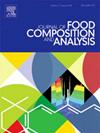基于介电光谱技术和机器学习方法相结合的鲜奶掺水水平无损检测
IF 4
2区 农林科学
Q2 CHEMISTRY, APPLIED
引用次数: 0
摘要
为快速实现鲜牛奶掺水鉴定和掺水量预测,本研究采用同轴探头和矢量网络分析仪,分析了介电常数ε'、介质损耗因子ε''和介质损耗角正切tanδ在2-20 GHz范围内100个频点的变化规律。基于全介质光谱建立了类类比软独立建模(SIMCA)、奈夫贝叶斯(NB)、K-近邻(KNN)和支持向量机(SVM)模型,用于定性检测牛奶中的掺假水平。利用连续投影算法(SPA)和无信息变量消除法(UVE)提取了全介电常数的特征变量。建立了偏最小二乘回归(PLSR)、支持向量回归(SVR)和粒子群优化最小二乘支持向量回归(PSO-LSSVR)模型,用于定量检测牛奶中的掺假水平。结果表明,随着频率的增加,ε''和tanδ呈上升趋势,而ε''呈下降趋势。ε''-SIMCA模型在鉴别牛奶中掺水的效果最好,准确度(ACC)为1,灵敏度(SNS)为1,特异性(SPC)精度(PRE)为1,F1得分(F1)为1。 tanδ-SPA-PSO-LSSVR模型对牛奶水分含量的预测效果最佳,RP2为0.994,RMSEP为0.016 %。该研究有利于构建更全面的鲜奶掺水知识体系。其结果可为天然牛奶无损检测仪器的开发提供理论参考。本文章由计算机程序翻译,如有差异,请以英文原文为准。
Non-destructive detection of water adulteration level in fresh milk based on combination of dielectric spectrum technology and machine learning method
To rapidly realize the identification of fresh milk for water adulteration and to predict the amount of water adulteration, this study adopts a coaxial probe and a vector network analyzer to analyze the variation laws of dielectric constant ε', dielectric loss factor ε'' and dielectric loss angle tangent tanδ in the range of 2–20 GHz under 100 frequency points. Soft independent modeling of class analogy (SIMCA), Naive Bayes (NB), K-nearest neighbors (KNN), and support vector machine (SVM) models were built based on full dielectric spectra for qualitative testing of adulteration levels in milk. Feature variables of FDS were extracted by using the successive projections algorithm (SPA) and uninformative variables elimination (UVE). Partial least squares regression (PLSR), support vector regression (SVR), and particle swarm optimization least square support vector regression (PSO-LSSVR) models were built for quantitative testing of adulteration levels in milk. The results demonstrate an increasing trend of ε'' and tanδ with increasing frequency and a decreasing trend of ε'. The ε'-SIMCA model achieves the best effect in distinguishing water adulteration in milk, showing accuracy (ACC) of 1, Sensitivity (SNS) of 1, Specificity (SPC) precision (PRE) of 1, and an F1-score (F1) of 1. The tanδ-SPA-PSO-LSSVR model optimally predicts the optimal prediction effect of moisture content of milk, showing an RP2 of 0.994 and an RMSEP of 0.016 %. This study is conducive to building a more comprehensive knowledge system of water adulteration in fresh milk. Its results can provide a theoretical reference in the development of non-destructive detection instruments for natural milk.
求助全文
通过发布文献求助,成功后即可免费获取论文全文。
去求助
来源期刊

Journal of Food Composition and Analysis
工程技术-食品科技
CiteScore
6.20
自引率
11.60%
发文量
601
审稿时长
53 days
期刊介绍:
The Journal of Food Composition and Analysis publishes manuscripts on scientific aspects of data on the chemical composition of human foods, with particular emphasis on actual data on composition of foods; analytical methods; studies on the manipulation, storage, distribution and use of food composition data; and studies on the statistics, use and distribution of such data and data systems. The Journal''s basis is nutrient composition, with increasing emphasis on bioactive non-nutrient and anti-nutrient components. Papers must provide sufficient description of the food samples, analytical methods, quality control procedures and statistical treatments of the data to permit the end users of the food composition data to evaluate the appropriateness of such data in their projects.
The Journal does not publish papers on: microbiological compounds; sensory quality; aromatics/volatiles in food and wine; essential oils; organoleptic characteristics of food; physical properties; or clinical papers and pharmacology-related papers.
 求助内容:
求助内容: 应助结果提醒方式:
应助结果提醒方式:


